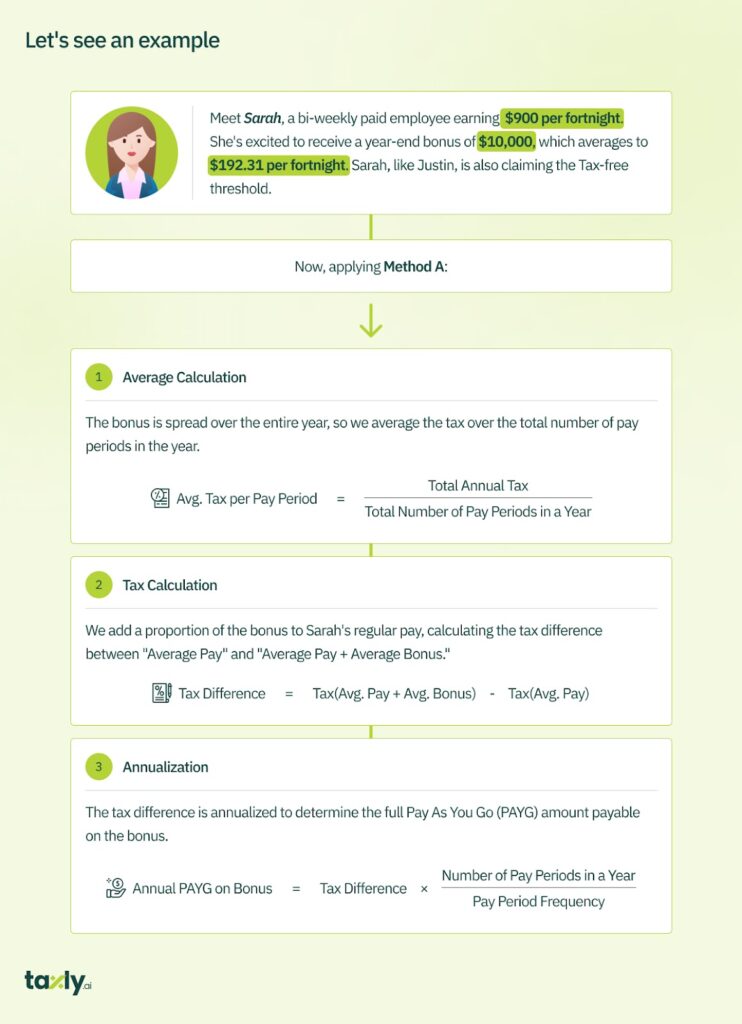Employee bonus payments are lump sum rewards handed out by employers to their hardworking staff. These bonuses serve as a way for employers to recognize and appreciate exceptional performance, often linked to specific achievements or targets over a defined period.
Now, let’s delve into the nitty-gritty of tax on bonus for Australian employees:
Tax on Bonus – Key Guidelines for Employers:
Payroll Tax:
- The Australian Tax Office (ATO) takes a uniform approach to bonuses and wages—they’re treated equally. Consequently, bonus payments fall under the umbrella of payroll tax.
- The specific amount of payroll tax you’ll be on the hook for depends on where your business operates and whether it surpasses the payroll tax threshold in the relevant state.
PAYG Withholding:
- As an employer, when you dole out those bonus payments, they find their way into your employees’ Pay As You Go (PAYG) payment summary under salary and wages.
- Each bonus can also be distinctly itemized on the PAYG withholding statement.
- Given that bonuses often reflect performance over multiple pay periods, they’re typically doled out annually, marking the culmination of the tax year.
- Importantly, bonus payments attract bonus tax, necessitating the withholding of taxes. The Australian Tax Office (ATO) lays down two distinct methods for calculating the withholding amount—precise instructions are conveniently available on their website.
Suggested Read: What Does Tax Withheld Mean in Australia?
How to Calculate Tax on Bonus?
Method A – Marginal Rate Method to Calculate Tax on Bonus
Method A, a straightforward and widely used way of calculating bonuses.
In Method A, bonuses are taxed at “marginal rates.” It’s important to clarify that these rates don’t directly align with the tax bracket of the employee’s regular earnings.
Taxing at marginal rates spreads the tax burden over time. For specific bonuses tied to a certain number of pay periods, like a half-yearly bonus, the calculation considers that period. For annual bonuses, the tax is averaged over the entire financial year.
In practical terms, a portion of the bonus is added to the employee’s regular pay. The tax difference between “Average Pay” and “Average Pay + Average Bonus” is then determined. This tax difference is annualized to calculate the full Pay As You Go (PAYG) amount payable on the bonus.

Keep in mind: When consulting tax tables, ignore the cents for simplicity.
According to ATO guidelines, the tax withheld from a bonus is capped at a maximum of 49% at the time of payment.
To ensure compliance, compare the total PAYG calculated on the bonus using marginal rates with a flat tax rate of 49%.
If the marginal rate exceeds 49%, cap the PAYG at this maximum. This approach ensures clarity, adherence to specific regulations, and compliance with ATO guidelines.
Additional Tax on Bonus Considerations for Employers:
1. Superannuation Guarantee:
Employers have an obligation to contribute to their employees’ superannuation guarantee on all regular hours worked, excluding unscheduled overtime.
This means that superannuation contributions need to be made on the gross amount of any bonus payments.
Adjustments to bonus amounts may be necessary to ensure that employees receive the intended net bonus after factoring in superannuation.
2. Applicability Across Employee Types:
These bonus rules extend to all types of employees—whether casual, full-time, or part-time. Even contractors may find themselves subject to these regulations.
3. Gift Bonus Payments:
An intriguing option for easing your employees’ tax burden on smaller bonuses is presenting them as non-monetary gifts.
If the value of such a gift remains below $300, it might qualify for an exemption from fringe benefits tax (FBT). However, this exemption hinges on the gift being infrequent and meeting other specified requirements.
Importantly, for these gift bonuses, there’s no obligation to withhold tax, record them on the annual PAYG payment summary, or contribute to the employee’s superannuation fund.
Tax on Bonus – FAQs
How are bonuses taxed in Australia?
Bonuses in Australia are generally taxed at marginal rates, averaging the tax over the pay periods related to the bonus. For example, if you receive a $5,000 bonus and you’re in the 32.5% tax bracket, the tax on the bonus would be $1,625 (32.5% of $5,000). The Australian Tax Office (ATO) provides detailed guidelines on bonus taxation methods.
How is back pay taxed in Australia?
Back Pay is taxed as ordinary income. If you receive back pay of $10,000 and your marginal tax rate is 37%, the tax on the back pay would be $3,700. It’s crucial to consider the specific period to which the backpay relates, as it can impact your overall tax liability for that financial year.
What are the payroll tax rates in Australia for 2023?
Payroll tax rates in Australia vary by state and territory. For instance, in New South Wales, the rate is 5.45% for 2023 on annual wages exceeding $1.2 million. However, in Victoria, the rate is 4.85% for annual wages exceeding $650,000. Consult the local revenue office for precise rates and thresholds in your jurisdiction.
What is the highest tax rate in Australia?
As of the latest information, the highest marginal tax rate in Australia is 45%. This rate applies to taxable income exceeding $180,001. It’s important to note that additional Medicare levy and surcharge may also apply for higher-income earners. Always refer to the ATO for the most current tax rate details.
Bonus Payments for Employees – The Bottomline
Your taxable income encompasses any bonuses received. When you review your annual payment summary, it should provide clarity on whether your employer has accurately withheld the appropriate amount of tax. This information proves crucial for ensuring your tax affairs are in order and align with the guidelines set forth by tax authorities.
Discover More Topics


Comments are closed